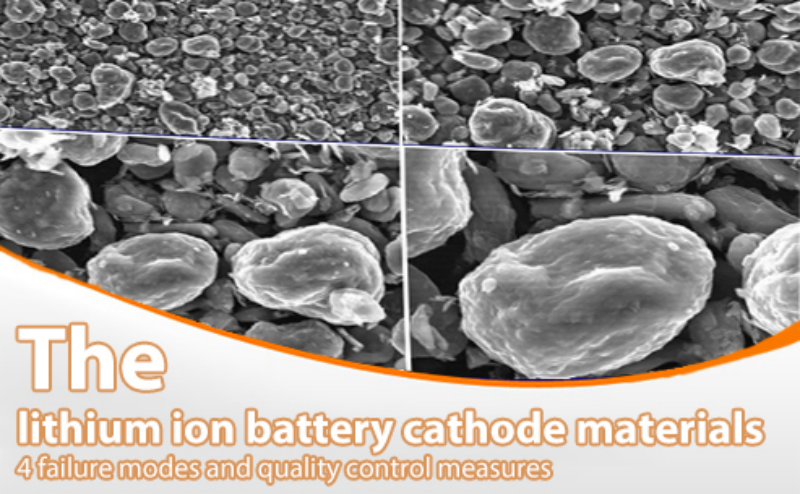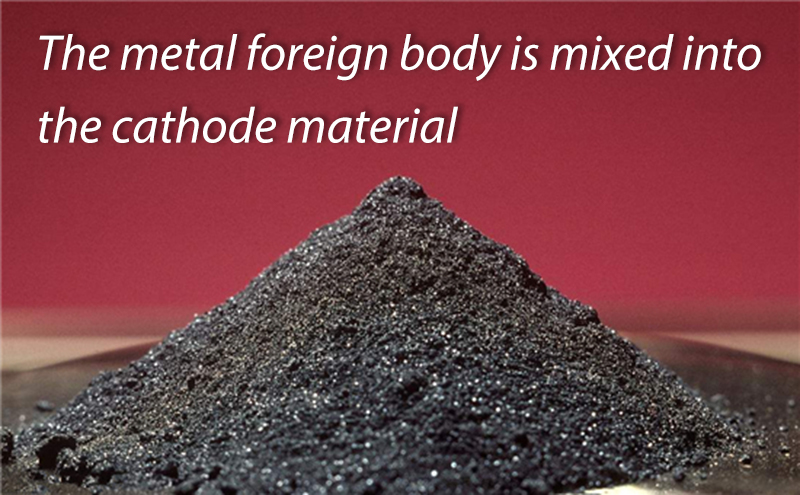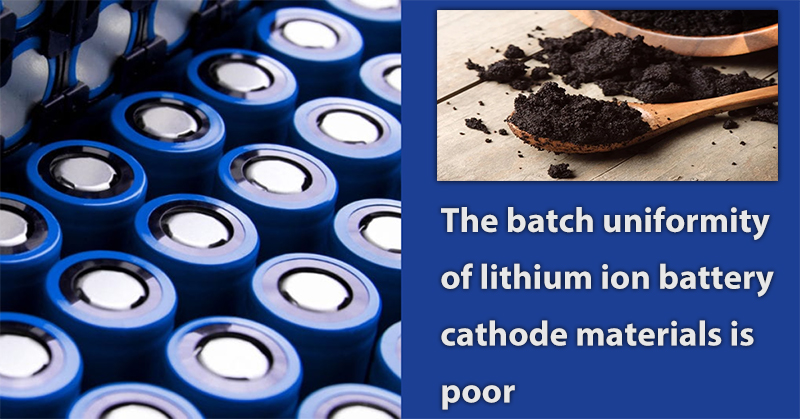
Main content:
The performance of lithium-ion batteries is closely related to the quality of the cathode material. The ternary cathode material used to prepare the ternary lithium battery, as a kind of lithium ion battery cathode materials, will also affect the battery consistency and safety issues. This article introduces several failure modes of lithium ion battery cathode materials that have a significant impact on the performance of lithium ion batteries, such as mixed metal foreign matter, excessive moisture, and poor batch consistency. The serious harm caused by these failure modes to the battery performance is clarified, and how to avoid these failures is explained from the perspective of quality management, so as to further prevent the occurrence of quality problems and improve the quality of lithium-ion batteries.
As we all know, the cathode material is one of the key core materials of lithium-ion batteries, and its performance directly affects the performance indicators of lithium-ion batteries. At present, the marketed lithium ion battery cathode materials include lithium cobalt oxide, lithium manganate, lithium iron phosphate and ternary materials. Compared with other raw materials for lithium-ion batteries, the variety of cathode materials is more diverse, the production process is more complex, and the risk of quality failure is greater, so the requirements for its quality management are higher. This article discusses the common failure modes of cathode materials for lithium-ion batteries and the corresponding preventive measures from the perspective of material users.
1.The metal foreign body is mixed into the cathode material
When there are metal impurities such as iron (Fe), copper (Cu), chromium (Cr), nickel (Ni), zinc (Zn), silver (Ag) in the lithium ion cathode battery materials, the voltage of the battery formation stage reaches these metals. After the redox potential of the element, these metals will be oxidized at the cathode and then reduced at the anode. When the metal element at the anode accumulates to a certain extent, the hard edges and corners of the deposited metal will pierce the separator, causing the battery to self-discharge.
Self-discharge can have a fatal impact on lithium-ion batteries, so it is particularly important to prevent the introduction of metal foreign matter from the source. The lithium ion battery cathode materials have many production processes, and each link in the manufacturing process will have the risk of introducing metal foreign matter, which puts forward higher requirements on the equipment automation degree and on-site quality management level of material suppliers. However, due to cost constraints, material suppliers often have a low degree of automation of their equipment, many production and manufacturing process breakpoints, and increased uncontrollable risks.

Therefore, in order to ensure stable battery performance and prevent self-discharge, battery manufacturers must promote material suppliers to prevent the introduction of metal foreign matter from 5 aspects: human, machine, material, method and environment. First of all, starting from personnel control, employees should be prohibited from bringing foreign metal objects into the workshop, and it is forbidden to wear jewelry. When entering the workshop, they should wear overalls, work shoes, and gloves to avoid contact with metal foreign objects and then powder. It is necessary to establish a supervision and inspection mechanism, cultivate the quality awareness of employees, and make them consciously abide by and maintain the workshop environment.
Production equipment is the main link for the introduction of foreign objects, such as rusting of equipment components and tools in contact with materials, and wear of inherent materials; Equipment parts and tools that are not in direct contact with the material will float into the material due to the air flow in the workshop after the dust adheres. Depending on the degree of impact, different treatment methods can be adopted, such as painting, replacing with non-metallic coating (plastic, ceramic), wrapping bare metal parts, etc. Managers should also formulate corresponding rules and regulations, clearly stipulate how to manage foreign metal objects, formulate checklists, and require employees to check regularly to prevent problems before they occur.
Raw materials are the direct source of metal foreign matter in lithium ion battery cathode materials. The purchased raw materials should be subject to regulations on the content of metal foreign matter. After entering the factory, strict inspection should be carried out to ensure that the content is within the specified range. If the metal foreign matter content of the raw material exceeds the standard, it is difficult to remove it in the subsequent process. In order to remove metal foreign matter, electromagnetic iron removal has become a necessary process in the production of lithium ion battery materials, and electromagnetic iron removal machines are widely used.
However, the equipment does not work on non-magnetic metal substances such as copper and zinc, so the workshop should avoid the use of copper and zinc parts. If it must be used, try not to directly contact the powder or expose it to the air. In addition, the installation position, number of installations, and parameter settings of the electromagnetic iron remover also have a certain influence on the iron removal effect. In order to ensure the workshop environment and realize the positive pressure of the workshop, it is also necessary to establish double doors and air shower doors to prevent external dust from flowing into the workshop contaminated materials. At the same time, the workshop equipment and steel structure should avoid rusting, and the ground should be painted and demagnetized regularly.
2.The moisture content of lithium ion battery cathode materials exceeds the standard
The lithium ion battery cathode materials are mostly micro or nano-scale particles, which can easily absorb moisture in the air, especially ternary materials with high-Ni content. When preparing cathode slurry, if the lithium ion cathode battery materials have high moisture content, the solubility of PVDF will be reduced after NMP absorbs water during the slurry stirring process, which will cause the slurry to gel in a jelly-like shape and affect the processing performance. After the battery is made, its capacity, internal resistance, cycle cathode and magnification will be affected. Therefore, the moisture of lithium ion battery pack materials should be the same as the metal foreign matter as a key control item.
The higher the automation of the production line equipment, the shorter the time the powder is exposed to the air, and the less moisture is introduced. Promoting material suppliers to improve the degree of automation of equipment, such as the realization of whole-process pipeline transportation, monitoring of pipeline dew point, and the installation of manipulators to realize automatic material loading and unloading make great contributions to preventing the introduction of moisture. However, some material suppliers are limited by plant design or cost pressure, the degree of equipment automation is not high, and the manufacturing process has many breakpoints, and the powder exposure time must be strictly controlled. The powder in the transfer process is preferably packed in nitrogen-filled barrels.

The temperature and humidity of the production workshop is also a key control indicator. In theory, the lower the dew point, the better. Most material suppliers will focus on moisture control after the sintering process, and they believe that a sintering temperature of around 1000 degrees can remove most of the moisture in the powder. As long as the introduction of moisture from the sintering process to the packaging stage is strictly controlled, it can basically ensure that the moisture content of the material does not exceed the standard. Of course, this does not mean that there is no need to control moisture before the sintering process, because if too much moisture is introduced in the previous process, the sintering efficiency and the microscopic morphology of the material will be affected.
In addition, the packaging method is also very important. Most material suppliers use the aluminum-plastic bag vacuum packaging method. At present, this method is still the most economical and effective. Different material designs will have great differences in water absorption, such as differences in coating materials, differences in specific surface area, etc., which will affect its water absorption. Although some material suppliers prevent the introduction of moisture during the manufacturing process, the material itself has the characteristics of easy water absorption, and it is extremely difficult to bake out the moisture after the pole piece is made, which causes trouble for battery manufacturers. Therefore, the problem of water absorption should be considered when developing new materials, and the development of materials with higher universality is of great benefit to both supply and demand.
3.The batch uniformity of lithium ion battery cathode materials is poor
For battery manufacturers, the smaller the batch-to-batch variation of lithium ion battery cathode materials and the better the consistency, the more stable the performance of the finished battery can be. One of the main disadvantages of lithium iron phosphate cathode material is the poor batch stability. During pulping, the viscosity and solid content of each batch of pulp are often unstable due to large batch fluctuations, which brings trouble to users. , it is necessary to constantly adjust the process to adapt. Improving the automation of production equipment is the main means to improve the batch stability of lithium iron phosphate materials.
However, at present, the equipment automation degree of Chinese lithium iron phosphate material suppliers is generally low, the technical level and quality management ability are not high, and the materials provided have different degrees of batch instability. From the user's point of view, if batch differences cannot be eliminated, we hope that the larger the weight of a batch, the better, of course, the premise is that the materials in the same batch are uniform and stable. Therefore, in order to meet this requirement, iron and lithium material suppliers often add a mixing process after the finished product is made. That is, several batches of materials are uniformly mixed.

The larger the volume of the mixing kettle, the more materials it can hold, and the larger the amount of one batch mixed. The particle size, specific surface area, moisture, pH value and other indicators of iron-lithium materials will affect the viscosity of the slurry, but these indicators are often strictly controlled within a certain range. However, there will still be large differences in the viscosity of batches. In order to prevent abnormalities in batch use, some slurries are often prepared in advance by simulating the production formula before being put into use to test the viscosity, and then put into use after meeting the requirements.
Testing before each production will greatly reduce the production efficiency, so this work is forwarded to the material supplier, and the material supplier is required to complete the test and meet the requirements before shipping. With the advancement of technology and the improvement of the process capability of material suppliers, the dispersion of physical property indicators is getting smaller and smaller, and the step of testing the viscosity before delivery can be omitted. In addition to the above-mentioned measures to improve consistency, quality tools should be used to minimize this batch instability and prevent quality problems. Mainly from the following aspects.
① Establishment of operating procedures
The inherent quality of a product is designed and manufactured. Therefore, how the operator operates is particularly important for controlling product quality, and detailed and specific operating standards should be established.
② Identification of CTQ
Identify key indicators and key processes that affect product quality, conduct special monitoring on these key control indicators, and formulate corresponding emergency response measures. Orthophosphoric acid railway line is currently the mainstream for preparing lithium iron phosphate, and its processes include batching, ball milling, sintering, pulverization, packaging, etc. The ball milling process should be managed as a key process, because if the consistency of the primary particle size after ball milling is not well controlled, the particle size consistency of the finished product will be affected, which in turn will affect the batch consistency of the material.

③ Use of SPC
The key characteristic parameters of key processes are monitored by SPC from time to time, and abnormal points are analyzed to find out the cause of instability, take effective corrective and preventive measures, and prevent defective products from flowing to the client.
4.Other adverse conditions
During pulping, lithium ion battery cathode materials are evenly mixed with solvent, glue and conductive agent in a certain proportion in the pulping tank, and then discharged through the pipeline, and a filter screen is installed at the discharge port. Its purpose is to intercept large particles and foreign matter in the lithium ion battery cathode materials to ensure the quality of the coating. If the lithium ion cathode battery materials contain large particles, the filter will be blocked. If the large particles are still the lithium ion battery cathode materials themselves, it only affects the production efficiency and will not affect the battery performance, so the loss can be smaller.
However, if the composition of such large particles is uncertain, and it is other metal foreign matter, the slurry that has been made will be scrapped, and the loss will be huge. This abnormality should be caused by the internal quality management of the material supplier. Most of the production of lithium ion battery cathode materials has a screening process. Whether the screen is damaged, whether it is checked and replaced in time. When it comes to cathode material suppliers, you may want to know the relevant layout of leading companies in this field. Top 10 lithium battery ternary material companies on our website will provide you with details about the giants in ternary materials to help you get more industry information about cathode materials
















